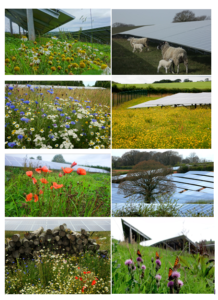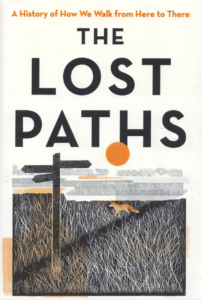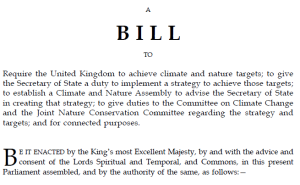Examples of trees and rivers that can be afforded protection:



PERSONHOOD – Briefing Note – Worldwide review, with some English examples.
From Dr John Feltwell, Dip EC Law of Wildlife Matters 07793 006832 john@wildlifematters.com
‘Personhood’ on your doorstep’ ‘Voiceless entities’
Summary
- The concept of assigning ‘personhood’ on natural assets is growing apace worldwide, and in UK too. Nature Laws (which includes ‘personhoods’) have now been introduced in USA (California, Hawaii), Ecuador, Bangladesh, Canada, England, Wales and Scotland.
2. In the UK at least TEN rivers have either been Declared as Personhoods, or are in the process of been Declared or their Rights are supported. At the present time, UK law has not yet caught up. ‘Personhood’ confers various rights.
3. ALL the rivers in Wealden were given rights by Charter in mid- 2025, and all the rivers in Rother have the concept of personhood and rights supported by the local authority, as per a Motion approved on 15 September 2025.
4. The ‘1066 Yew Tree’, 1,300 year old tree in the churchyard at St George’s Church, Crowhurst, East Sussex, had the concept of rights supported by Rother District Council on 15 September 2025 (to be considered by the Parish Council). It is associated with the Battle of Hastings, and is believed the first tree in the UK whose rights (see 9 rights below) have been supported by a local council: In their words “This Council supports the introduction into law of legislation which would require those taking decisions affecting trees to have regard to the trees’ rights to:
- exist and grow;
- have their own mycelium (underground fungi) protected;
- access to their adjacent root-wide-web;
- have their wellbeing protected for future generations;
- not to be wilfully injured or damaged;
- not to be killed;
- not to be polluted with poisons;
- have an articulated voice in the community; and
- hold polluters and vandals accountable.
Protection should be prioritised for trees that can be considered as a “heritage and/or cultural asset”, an important example being the Crowhurst 1066 Yew Tree which stands as a living link for our community with our history going back more than 1,300 years. It is an ancient native tree, an iconic landmark and an important local natural monument.
This Council therefore:
- welcomes the decision of Crowhurst Parish Council to support “personhood status ” for the 1066 Yew tree and invites them, together with the community of Crowhurst, to take on guardianship of the 1066 Yew Tree to protect it for future generations;
- will consider how to reflect this motion in its revised Rother Local Plan;
- will update the Council’s Climate Strategy Action Plan to reflect this motion;
- will continue to work in partnership with local environmental organisations to utilise this motion to support their work;
- will support proposals from community groups and organisations for similar declarations in respect of other Rother trees that can be considered as a “heritage and/or cultural asset”1; and 6. will inform local residents and inform local press/media of this decision.
The Motion on being put, was declared CARRIED.
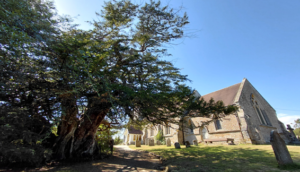
1066 Yew Tree at St George’s Church, Crowhurst, E. Sussex 2025
UK laws
Environmental Lawyers have been asking themselves how UK law can be used to protect natural habitats (assets).
In Crowhurst (E. Sussex) there are several natural assets that are being prepared for declaration of personhood.
Some of these are already afforded some limited ‘protection’ under UK law such as being in an SSSI, or in the AONL, or being TPO’d, or protected under NPPF 2025, or of Ancient, Amenity or Heritage value, or being in a international ‘Natura 2000’ site under EU law (seamlessly transposed into UK Law on Brexit). The UK appears to have a lot of wildlife protection, but in reality it is not enough, and it is not really ‘protected’ in the long term.
People in the UK are becoming concerned with the pollution of their streams and rivers. Regardless of how ‘protected’ rivers can be, for instance the valuable chalk-stream of the River Test which has parts officially designated as a Site of Special Scientific Interest (SSS) – the cream of the cream of the best natural history sites in the UK – are under serious threat from pollution. The UK law in its current state is not helpful, and no reliance can be had on it.
All rivers in Hampshire, Rother District and Wealden District were afforded protection in 2025.
Currently UK and EU wildlife and habitat law is not enough to protect natural assets – think twelve SSSIs removed for HS2. Widespread decline of species is now attributed to man-made actions – we are in the Anthropocene.
Now is time to consider ‘personhood’. People and ships have attributed personhood and can assert their rights. So the next stage is for natural assets such as trees, woodlands, rivers and wetlands to assert their rights. Many habitats and species already have their own UK ‘protections’ on paper, but they cannot speak for themselves. We are their voices.
As Emma Montlake of Environmental Law Foundation (ELF) said ‘I believe that nature has its own intrinsic rights to exist and thrive and that you cannot put a financial value on that. I also believe that we have a moral responsibility to protect nature.’
Data Trawl
This author, with the assistance of the Librarian at The Linnean Society in Piccadilly has trawled the data bases and recorded no information on personhoods, as such, or what might have been otherwise called.
Also a note (see below) has been put onto the Linn Soc’s webfeed asking for any historical information regarding any Fellow’s particular interest in a particular habitat that needs protection.
John Feltwell FLS would like to know if any Fellows have any examples on the concept of ‘Personhood’, or indeed are working on the subject. This is an intriguing concept in the developing world of conservation whereby a ‘Personhood’ can be assigned to a natural asset such as a river or wood or a valley, just as it is assigned to a person or a ship. The law is not entirely firmed-up at this moment. There are already examples in Hawaii and New Zealand and it is now emerging in the UK. For example certain rivers in England are now being represented ‘in person’ on catchment boards (by people on their behalf), as designated entities (Personhoods) so that their interests can be supported (e.g. from damage and pollution) by others as they cannot speak for themselves. A trawl of Linn Soc annals has proved negative, but it may be that someone in the past may have sought to particularly protect a habitat in the manner of a Personhood, or precursor. Contact: john@wildlifematters.com 07793 006832
There were no responses to this webfeed from Fellows.
Earlier texts that mention the subject may be found at
Stone, C. D. 1971. Should Trees Have Standing? And Other Essays on Law, Morals and the Environment. New York, Oceana Publications. [1]
Cullinan, C. 2003. Wild Law, A manifesto for Earth Justice. Totnes, Green Books. In association with The Gaia Foundation, London.
Woodlands and Forests
Futureproofing for RSPB Fore Wood (Crowhurst, East Sussex) – up for sale (2024) – perhaps personhood?
For a fixed natural habitat such a ‘RSPB Fore Wood’ it needs a voice to speak to those who have powers to protect it. Residents might be minded to assert Fore Wood’s personhood rights with Rother District Council simply to register its interests because it cannot. After all the woodland helps to make the community people live in and the countryside enjoyed. Fore Wood cannot speak for itself if it is sold. (there is a current possibility as RSPB are re-classifying their sites (in 2024), and Fore Wood is in class 4 = to be moth-balled or sold). The situation now (July 2025) is that RSPB are not actively seeking a sale. Personhood of Fore Wood is not currently being pursued.
In New Zealand – The Te Urewera Forest in New Zealand now has rights. This is an extract from the EJLC Rights of |Trees and Woodlands toolkit
“Enacted in 2014, the Te Urewera Act (TUA) radically changed the management of Te Urewera by pioneering a ‘new model of RON… that differs greatly from the Nature’s rights model adopted in Ecuador and Bolivia’.4 The TUA granted the Te Urewera legal personhood, recognising a ‘particular ecosystem as a legal person’5 by appointing specific guardians to speak and represent the forest in legal and policy arenas. Essentially, Indigenous members of the community act as guardians (in a legal sense as well as a social one) within governance institutions to advocate on behalf of it as a living being”.
Trees
As far as is known there are no trees with rights in the UK.
Now we can report that the Crowhurst’s ‘1066 Yew Tree’ had its rights supported by Rother District Council on 15 Sept. 2025.
A first.
The 1066 Yew tree (in Crowhurst Churchyard)
A good example for rights (supported by the Council) is the 1066 Yew Tree in the churchyard. It is thought to be about 1,300 years old. It is female (as it has berries), so perhaps one should assert her rights with Rother, and / or the Church who have been guardians of it whilst 30 generations of Crowhurst parishioners have appreciated it and been buried beneath it.
There are trees with rights around the world:
In India – trees have been declared legal persons – although nothing much has come from this 2017 ruling.
In USA – There is one known from USA (Athens) – a white oak which was the subject of a Deed of rights. At the local level, local ordinances have been used to recognise that ecosystems have rights, these are binding.
In France, tree rights were proposed by the French National Assembly in 2019 with the following summary:
Summary of French Tree Rights:
In 2018, the group Déclaration Universelle des Droits de L’arbre began a global petition to draft a universal declaration of tree rights. In 2019, the French National Assembly adopted its own version of the declaration spearheaded by Delphine Batho, president of the French political environmentalist party Génération écologie. The declaration recognized that a tree “should be respected throughout its life and have the right to develop and to reproduce freely, from its birth to its natural death, whether it be a town tree or a country tree. A tree should be considered as a subject of law, including when laws regarding human property are involved.”
11th February 2019 Declaration of tree Rights as it will be proclaimed at the National Assembly’s symposium on April 5, 2019.
Article 1 The tree is a fixed living being, which, in comparable proportions, occupies two distinct environments: the atmosphere and the soil. In the soil grow roots, which capture water and mineral. In the atmosphere grows the crown, which captures carbon dioxide and solar energy. By this situation, the tree plays a fundamental role in the ecological balance of the planet.
Article 2 The tree is a living being sensitive to changes in its environment. It must be respected as such. It should not be reduced to a simple object. It is entitled to the airspace and underground that is necessary for it to achieve its full growth and reach its adult dimensions. In these conditions the tree has rights for respect of its physical integrity: whereas it is aerial (branches, trunk, foliage) or underground (root network). The alteration of these organs severely weakens the tree, as does the use of pesticides and other toxic substances.
Article 3 The tree is a living organism whose average longevity far exceeds that of the human being. The tree must be respected throughout its life, with the right to develop and reproduce freely, from its birth to its natural death, whether it is a tree of cities or campaigns. The tree must be considered as a subject of law, including within the rules governing human property.
Article 4 Some trees, considered remarkable by man, for their age, appearance or history, deserve extra attention. By becoming a common bio-cultural heritage, they have access to a higher status, committing man to protect them as “natural monuments”. They can be enrolled in an area of preservation of the landscape heritage, thus benefiting from enhanced protection and development for aesthetic, historical or cultural reasons.
Article 5 To meet the needs of man, some trees are planted and then exploited, escaping the criteria mentioned above. However, the operating modalities of forest and rural trees must take into account the life cycle of trees, natural renewal capacities, ecological balances and biodiversity.
The aim of this text is to change the behaviour of man, to make them aware of the decisive role of trees in everyday life and for the future, by paving the way for a rapid change in legislation at national level
Watercourses
We all hate to see our watercourses polluted with sewage and chemical pollutants. Crowhurst settlement was established around a stream and has been reliant upon that water (The Powdermill Stream), so the stream needs to have a voice as it is part of the fabric of the village. As a start, the stream should have a personhood, so that, through vigilance and control, its waters could be passed on downstream to other parishes. It is time to register the Powdermill Stream.
There is some ‘protection’ offered via the National Planning Policy Framework (NPPF) (latest update 7.2.25), as per
The NPPF is useful in planning for its clear protection of natural capital, even on trees and landscapes, and threats to trees, under four NPPF paragraphs.
Existing Legal Protection – nationally (UK)
There is already existing legal protection for rivers and natural assets, by way of the National Planning Policy Framework (NPPF) [i] under the following paragraphs, which are within the important section 15. Conserving and enhancing the natural environment.
| Paragraph |
Item |
| 106, 107 |
protected under Local Green Spaces |
| 187a |
‘protecting and enhancing valued landscapes’ and ‘sites of biodiversity’ |
| 216 |
Protection of non-designated assets |
Precedents – River protection in the UK to date.
(not exclusive list – more to come)
There have been several known projects in the United Kingdom:
Example 1. River Ouse, East Sussex. In 2024 Lewes Town Council accepted a Declaration from the local group ‘Love Our Ouse’ (LOO) for ‘the right (the river) to an influential voice in decisions that effect it.’ Now the River Ouse has an official voice. [1]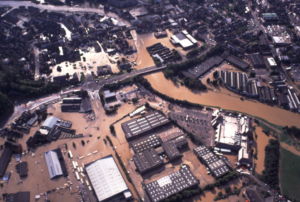 The River Ouse flooding Lewes (East Sussex) 13 Oct 2000 – raising the legal issue of who is to blame? Who to sue? Who can sue? The River Ouse flooding Lewes (East Sussex) 13 Oct 2000 – raising the legal issue of who is to blame? Who to sue? Who can sue?
Example 2 All Rother Rivers with supported rights from Rother District Council, 15 Sept 2025.
RIGHTS OF ROTHER RIVERS
“This Council supports the growing global movement for rights for nature in general and for rivers in particular, as a framework for rethinking the relationship between human beings and the natural world.
This Council supports the introduction into law of the following rights for rivers:
- the right to flow;
- the right to perform essential functions within their ecosystems;
- the right to be free from pollution;
- the right to feed, and to be fed by, sustainable aquifers;
- the right to native biodiversity;
- the right to regeneration and restoration; and
- the right to have an articulated voice in the community.
This Council therefore:
1. supports the above rights (1-7) in relation to Rother rivers and water courses; supports the creation of ecologically sound management plans for particular water courses;
- will respond positively to proposals from community groups and organisations as they develop and enhance their management plans based on these rights;
- will consider how to reflect this motion in its Revised Local Plan;
- will update the Council’s Climate Action Plan to reflect this motion; and
- will inform local residents and inform press/media of this decision.
The Motion on being put, was declared CARRIED.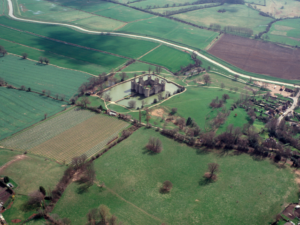
The River Rother, in Rother, flows past Bodiam Castle
|
Example 3. All Wealden rivers. Motion passed to protect Wealden’s rivers and ] coasts. July 2025.[iii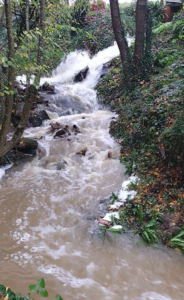 A Wealden stream in spate, in The High Weald Area of National Landscape (AONL) A Wealden stream in spate, in The High Weald Area of National Landscape (AONL) |
|
Example 4. River Frome, Somerset,. Residents in Frome (Somerset) tried to get the River Frome protected via a Bye-Law in 2018, but this was rejected by DEFRA in 2020. It was proposed by Frome Town Council on behalf of the Friends of the River Frome. |
| Example 5 River Cam, Cambs. Residents in Cambridge, the Friends of the Cam held a ceremony to establish the rights of their river based on the ‘earth Law Centre’s Universal Declaration of River Rights’ .that the river had a right to flower, to be free of abstraction and pollution, and to host native biodiversity’,[2] |
| Example 6. River Helford, Cornwall. Petition to grant UK Rivers & Rias Legal Personhood starting with Cornwall’s Helford River…to recognise the Helford River as a living entity to ‘her’ own voice by adopting the Universal Declaration of River Rights (UDRR), appoint a Lead Legal Guardian… Created by the Voices of Water Foundation (WoW). [iii] |
|
| Example 7. The River Wye, Wales. This border river between England and Wales is described as an environmental jewel for its biodiversity, but its water quality is under attack from pollutants; locals want to see personhood granted. [iv] The ‘Save The Wye’ group say on their website that the River Wye is being killed by pollution caused by excessive agricultural nutrients, sewage, microplastics and superbugs. They give the river a voice…’I am river, hear my voice’…
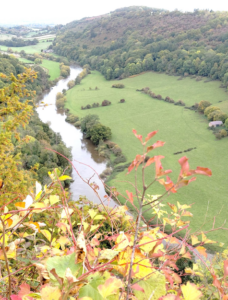 Symonds Yat, River Wye, Oct 2025 Symonds Yat, River Wye, Oct 2025
Example 8, River Usk, Wales. The river now has its own place at the Committee table on the ‘Usk Catchment Partnership.[3][1]
Example 9 River Lugg- see below
In Oct 2025 the UK’s largest environmental lawsuit was issued against a poultry producer and a water company about river pollution in three rivers (Wye, Lugg and Usk). One quarter of the UK’s poultry is raised in the catchment area of these rivers. At risk are otters, freshwater pearl mussels and Atlantic salmon, as well as the well-being of people along the 155 miles of the River Wye (BBC Wales, 7 Oct 2025: represented by Leigh Day Lawyers). |
| Example 10, River rights in Hampshire. River Test. Basingstoke and Deane BC passed a motion on river rights, especially chalk streams (particularly the River Test) in the Hampshire and Isle of Wight area, strongly supported by their local groups. They did not grant rights but decided to explore, like Lewes.
Example 11 River Loddon. Hampshire. Granted Personhood by Basingstoke and Dean Borough Council in May 2025. |
| Example 12. Scotland, Glasgow. River Clyde [1] A submission was made by the Earth Law Centre [1], following the ‘Universal Declaration of River Rights’. The rights sought included the following:
1. Rights to exist as a living entity
2. Rights to have fundamental rights
3. Rights to have a flow
4. Rights to be free of pollution
5. Rights to have native biodiversity
6. Rights to regenerate and restoration
7. Rights to be fed, and to sustain an aquifer
(cf. Louise Welsh and Jude Barber) Podcast on ‘Who owns the Clyde) |
River protection OVERSEAS (not exclusive list – more to come)
| Example 13. France, River Seine, Paris. The Mayor of Paris, Anne Hidalgo, announced that she called on Parliament to pass a law giving the River Seine rights, so that ‘an independent guardian authority’ can defend it in court. |
| Example 14. New Zealand. Legislation now protects the Whanganui River that the Maori people have always believed it is a living entity. |
| Example 14. Canada, Magpie River. In 2021, th Innu Council of Ekuanitshit with others granted Magpie River the right of legal personhood, which bestowed nine rights: [v] |
Personhood has a worldwide perspective:
USA. Hawaii has personified nature.
My colleague (and fellow Trustee of a rainforest trust in Brazil), Professor Sir Ghillean Prance FRS, VMH (Director of the Royal Botanic Gardens, Kew, 1988-1999) writes that ‘The system in Hawaii of sacred valleys is called ahupua’a. The one I know of is the Limahuli valley in Kauai, but I think the one personified may be in Kona.’
As Emma from Environmental Law Foundation (ELF) stated: ‘We are on a rights journey, we recall the suffragettes and the civil rights movement in America. It is in our gift to grant rights to nature.’
UK law on personhood is very much in its infancy with currently no particular helpful laws.
USA. California
A series of habitats in Orange County tried to sue a developer and the state to try to stop a housing developer. This is the first time in the USA that habitats have tried to use ‘nature laws’ in the court.
In Canada
The Magpie River. In February 2021 Canada passed a nature law giving nine rights to the river including rights to be safe from pollution and the right to sue, and assign legal guardians to ensure those rights are respected. The river is being ‘defended from death by damming in a river-rights campaign.’ (R. Macfarlane, 2025)[8]
In Bangladesh All rivers in the country were given explicit rights of protection in 2019.
In Ecuador Ecuador has an existing law that gives nature ‘a right to exist, persist, maintain and regenerate’. This has been tested in court, but not successfully yet.
In New Zealand two areas have now been recognised: A National Park and the Whanganui River. They now own themselves. Extract:
“In 2014, an Act of the Aotearoa New Zealand Parliament recognised the 2,127 square kilometre former Te Urewera National Park as being a ‘legal entity’ possessing ‘all the rights, powers, duties, and liabilities of a legal person’.
In March of 2017, another enactment acknowledged the country’s 300-kilometre-long Whanganui River as ‘a legal person [with] all the rights, powers, duties, and liabilities of a legal person’. In late 2017, the Crown and Taranaki Māori signed a record of understanding that Parliament will in the future legislate to grant the 2,518-metre-tall Mount Taranaki/Mount Egmont legal personhood.
By virtue of these legislative acts, the various geographic entities gain an independent existence in the eyes of the law. Rather than being mere Crown or public property, they own themselves. They are deemed to be holders of their own rights, which may be asserted in legal proceedings and other fora. In short, they are no longer ‘things’ over which human beings exercise dominion; they are ‘persons’ with which humans have a relationship..”
The final word to date is from O’Donnell and Kerslake, (2021)[9] who say there have been
- ‘substantive shifts in theory and law on legal personhood’,
- that there have been profound legal commitments to the full personhood of disabled people,
- that there are dramatic new applications of personhood of animals
- and that dramatic new applications of personhood to natural entities such as rivers’
Process of registration
In the UK it seems that the usual way of seeking personhood registration is to approach the Council by way of a Petition, or a Declaration (both have been used). Also it can be done by creating a Bye-Law.
There are two types of bye-laws.
- a regulation made by a local authority or corporation.
- a rule made by a company or society to control the actions of its members.
Some guidance is to be found in the following 2024 Toolkit. ‘How to Protect Rivers in England and Wales. [10]
Further information from around the world:
The following countries are in the process of seeking personhoods of rivers, watersheds, lagoons, oceans, nature in general, trees and whales…..
Search any of these on-line to find plenty of further information.
The list is not exhaustive of countries seeking personhoods:
| Brazil: Linhares |
2024 |
Rights of the Waves |
| Canada: Labrador |
2023 |
The rights and legal personhood of the St Lawrence River |
| Finland |
2023 |
Animal Rights |
| France |
2019 |
Universal Declaration of Tree Rights |
| France: Corsica |
2021 |
Rights of Tayignanu river |
| India |
2022 |
Legal Personhood of the Bharathapuzha River |
| Mexico |
2023 |
Rights of the Ring of Cenotes |
| Netherlands |
2023 |
Rights of the Maas/Meuse River |
| Netherlands: Ejjsden-Margraten |
2023 |
Rights of Nature |
| Pacific Islanders |
2024 |
Rights of the Oceans and Whales |
| Poland |
2023 |
Legal Personality of the Oder river |
| Spain |
2022 |
Legal Personality of the Mar Menor Lagoon |
| USA: Hawaii |
2024 |
Rights of Watersheds |
Acknowledgements
Will Beharrell, Librarian, Linnean Society, Piccadilly
Emma Montlake, Co-director, Environmental Law Foundation (ELF)
Jo Smallwood, Assistant Professor of Law, School of Law, University of Sussex.
Andrew Swan, FLS, Governance Manager, Linnean Society, Piccadilly.
Further debate can be found at
Geddis, A. & Rutu, J. Places as Persons: Creating a New Framework for Maori-Crown Relations. https://www.bloomsburycollections.com/monograph-detail?docid=b-9781509930401&tocid=b-9781509930401-chapter11
Cf. also The Frontiers of Public Law, Ed by Jason NE Varuhas and Shona Wilson Stark. 2019.
Bibliography
A small article by John Feltwell on ‘Personhood on Your Doorstep’ appeared in Crowhurst News (Feb.25)
Dr. John Feltwell, Dip EC Law UPDATED 18 Sept 2025
BSc (Hons Zoology), PhD (Botany), FLS, FRES, FRSB, FLLA, Dip EC Law. Henley’s Down, Battle, TN33 9BN. 07793 006832 john@wildlifematters.com
[1] Stone, C.D.,1971 Should Trees Have Standing?- Towards Legal Rights for Natural Objects. https://iseethics.wordpress.com/wp-content/uploads/2013/02/stone-christopher-d-should-trees-have-standing.pdf
[2] Kaminski, I., 2021 (17th July). Laws of nature: could UK rivers be given the same rights as people? Guardian.org.
[3] Emma Montlake, ELF, pers.comm. 20 Jan 2024 & July 2025.
[4] Love Our Ouse, 2025. ‘First River in UK to have its Rights Recognised. https://loveourouse.org/wp-content/uploads/2025/02/Press-Release-Rights-of-River-Charter-for-the-River-Ouse-1.pdf
[5] The Times, Dec 18th 2024. By Lizzie Roberts. ‘River Clyde should get the same rights as people’.
[6] The Earth Law Centre (founded in 2008, as a non-profit), has its main office in Colorado, USA, and its seeks to Align our laws with Nature’s laws, ‘Earth law is the idea that ecosystems have the right to exist, thrive, and evolve – and that Nature should be able to defend its rights, just like people can.’ Our aim is to mitigate the effects of climate change, biodiversity loss, and degradation of ecosystems and to restore a flourishing Earth community on behalf of present and future generations of all species. It coined the expression ‘voiceless entities’. Earth Law Centre https://www.earthlawcenter.org/.
[7] Welsh L, & Barberm J, 2024. Podcast. ‘New podcast investigates who owns the river Clyde and why this matters to the people of Glasgow.
https://www.collectivearchitecture.co.uk/news/2024/new-podcast-investigates-who-owns-the-river-clyde-and-why-this-matters-to-the-people-of-glasgow
[8] Robert Macfarlane, 2025. Is a River Alive?’ Penguin Books
[9] O’Donnell, E. and Arstein-Kerslake, A. (2021). Pages 339-347 | Published online: 20 March 2022 https://www.tandfonline.com/doi/full/10.1080/10383441.2021.2044438
[10] Kings College London Legal Clinic, 2024. A Rights of Nature Toolkit: How to Protect Rivers in England and Wales. 130pp. https://www.kcl.ac.uk/legal-clinic/assets/rights-of-nature-toolkit.pdf
[i] NPPF, version 07.02.25
[ii] Wadhurst PC/ July 27 2025. Motion passes to protect Wealden’s rivers and coasts. https://wadhurst-pc.gov.uk/notices/motion-passed-to-protect-wealdens-rivers-and-coasts/
[iii] Edwards, K., 13 June 2025. Voice of Water (VoW) Petition to Grant UK Rivers & Rias Legal Personhood. https://cornwallvsf.org/climate-and-environment/voice-of-water-vow-petition-to-grant-uk-rivers-rias-legal-personhood/
[iv] Dennis, C., 09-07-2024. Why the River Wye needs legal personhood https://bylines.cymru/environment/river-wye-personhood/ (accessed 26 July 2025).
[v] This pristine Canadian river has legal personhood, a new approach to conserving nature. Feb 1 2024. https://www.indigenouswatchdog.org/update/this-pristine-canadian-river-has-legal-personhood-a-new-approach-to-conserving-nature/
ends

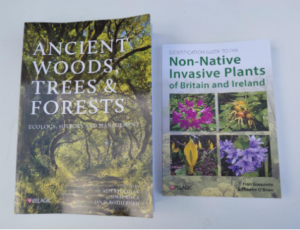
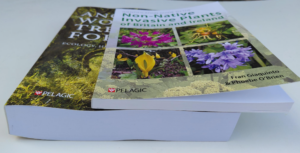





 The River Ouse flooding Lewes (East Sussex) 13 Oct 2000 – raising the legal issue of who is to blame? Who to sue? Who can sue?
The River Ouse flooding Lewes (East Sussex) 13 Oct 2000 – raising the legal issue of who is to blame? Who to sue? Who can sue?

 Symonds Yat, River Wye, Oct 2025
Symonds Yat, River Wye, Oct 2025



